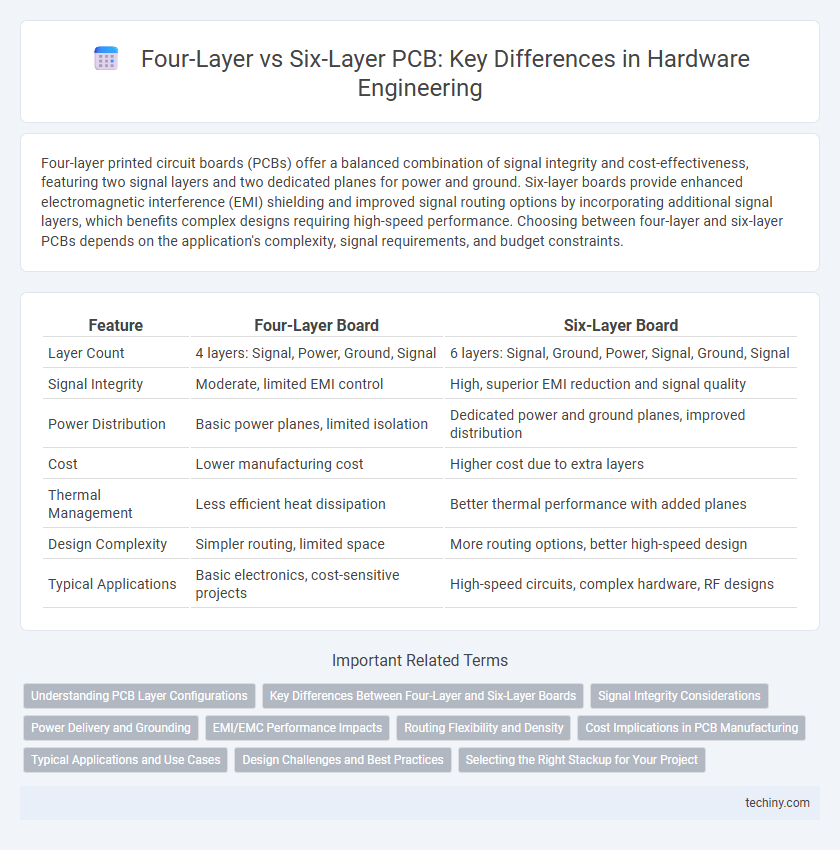Four-layer printed circuit boards (PCBs) offer a balanced combination of signal integrity and cost-effectiveness, featuring two signal layers and two dedicated planes for power and ground. Six-layer boards provide enhanced electromagnetic interference (EMI) shielding and improved signal routing options by incorporating additional signal layers, which benefits complex designs requiring high-speed performance. Choosing between four-layer and six-layer PCBs depends on the application's complexity, signal requirements, and budget constraints.
Table of Comparison
| Feature | Four-Layer Board | Six-Layer Board |
|---|---|---|
| Layer Count | 4 layers: Signal, Power, Ground, Signal | 6 layers: Signal, Ground, Power, Signal, Ground, Signal |
| Signal Integrity | Moderate, limited EMI control | High, superior EMI reduction and signal quality |
| Power Distribution | Basic power planes, limited isolation | Dedicated power and ground planes, improved distribution |
| Cost | Lower manufacturing cost | Higher cost due to extra layers |
| Thermal Management | Less efficient heat dissipation | Better thermal performance with added planes |
| Design Complexity | Simpler routing, limited space | More routing options, better high-speed design |
| Typical Applications | Basic electronics, cost-sensitive projects | High-speed circuits, complex hardware, RF designs |
Understanding PCB Layer Configurations
Four-layer boards offer a balanced configuration with dedicated layers for signal routing, power distribution, and ground planes, making them ideal for moderate complexity designs requiring improved signal integrity and reduced electromagnetic interference. Six-layer boards provide enhanced routing capacity by adding extra signal layers, which supports higher-density circuits and better isolation between signals, power, and ground, crucial for complex, high-speed hardware engineering projects. Selecting between four-layer and six-layer PCBs depends on design complexity, signal requirements, and manufacturing cost considerations.
Key Differences Between Four-Layer and Six-Layer Boards
Four-layer boards typically consist of two signal layers, one power plane, and one ground plane, offering improved signal integrity and reduced electromagnetic interference compared to two-layer boards. Six-layer boards add two extra layers, often used for additional signal routing or dedicated power and ground planes, enhancing performance for high-speed and complex circuits. The increased layering in six-layer boards supports better power distribution, noise reduction, and design flexibility, making them ideal for advanced hardware engineering applications.
Signal Integrity Considerations
A six-layer board offers superior signal integrity compared to a four-layer board by providing dedicated power and ground planes that reduce electromagnetic interference and crosstalk. Enhanced layer stacking in six-layer boards enables better impedance control, minimizing signal reflections and ensuring consistent transmission lines. Four-layer boards may suffice for simpler designs, but six-layer boards excel in high-speed applications requiring stringent noise reduction and signal clarity.
Power Delivery and Grounding
A six-layer board offers enhanced power delivery and grounding performance compared to a four-layer board by providing dedicated power and ground planes that reduce electromagnetic interference and voltage drops. The additional layers enable better current distribution and improved signal integrity critical for high-speed and high-power applications in hardware engineering. Effective separation of power and ground planes in six-layer boards ensures lower impedance paths, minimizing noise and enhancing overall system reliability.
EMI/EMC Performance Impacts
Four-layer boards typically offer basic EMI/EMC performance, utilizing dedicated ground and power planes to reduce noise and crosstalk. Six-layer boards enhance EMI/EMC performance by incorporating additional signal and return layers, which improve shielding and reduce electromagnetic interference more effectively. The extra layers in six-layer boards enable better control of impedance and signal integrity, critical for high-frequency hardware engineering applications.
Routing Flexibility and Density
Six-layer boards offer enhanced routing flexibility and higher density due to additional signal and power planes, allowing for more complex circuit designs and improved electromagnetic compatibility. Four-layer boards provide moderate routing options but may require compromises in trace length and layer transitions, limiting high-speed signal integrity and component placement efficiency. Choosing six-layer boards supports advanced multi-signal routing and tighter component layout essential for modern hardware engineering projects.
Cost Implications in PCB Manufacturing
Four-layer PCBs generally offer lower manufacturing costs due to reduced material use and simpler production processes compared to six-layer boards. Six-layer PCBs, while more expensive, provide enhanced signal integrity and electromagnetic interference (EMI) control, often justifying the higher cost in complex hardware designs. Cost implications depend on design requirements, with four-layer boards suitable for budget-sensitive projects and six-layer boards favored for advanced electrical performance.
Typical Applications and Use Cases
Four-layer boards are commonly used in consumer electronics, automotive controls, and simple embedded systems where moderate signal integrity and cost efficiency are required. Six-layer boards provide enhanced signal performance and electromagnetic interference (EMI) reduction, making them ideal for high-speed communication devices, complex IoT systems, and advanced industrial controls. The additional layers in six-layer boards enable superior power distribution and ground plane stability, supporting demanding applications such as RF modules and multilayer processors.
Design Challenges and Best Practices
Four-layer boards offer simpler design and reduced cost but face challenges with signal integrity and EMI due to limited layer availability for power and ground planes. Six-layer boards provide enhanced routing flexibility and improved noise reduction by incorporating dedicated layers for signal, power, and ground, addressing complex high-speed design demands effectively. Best practices include careful stack-up planning, minimizing crosstalk through strategic trace placement, and maintaining consistent impedance control to optimize performance in both board types.
Selecting the Right Stackup for Your Project
Choosing between a four-layer board and a six-layer board depends on your project's complexity and signal integrity requirements. Four-layer boards offer cost-effective solutions with essential power and ground planes, suitable for simpler circuits, while six-layer boards provide enhanced EMI control, improved routing density, and better thermal management, ideal for high-speed or high-density applications. Evaluating factors such as layer count impact on impedance control, crosstalk reduction, and manufacturing costs ensures optimal stackup selection tailored to project specifications.
Four-Layer Board vs Six-Layer Board Infographic

 techiny.com
techiny.com